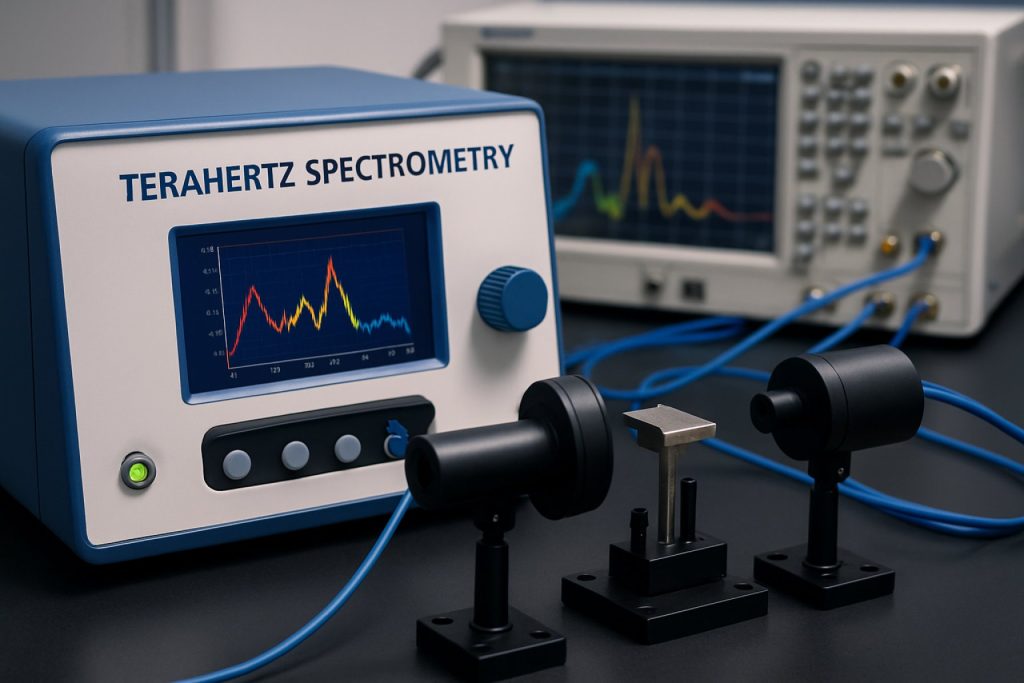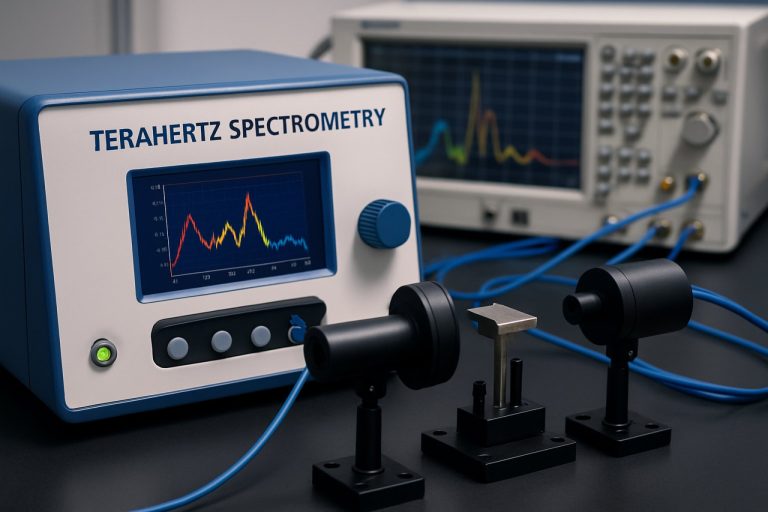
Terahertz Spectrometry Instrumentation in 2025: Market Acceleration, Breakthrough Technologies, and Strategic Opportunities. Explore how this sector is set to redefine analytical capabilities and drive double-digit growth through 2030.
- Executive Summary: Key Findings and Market Highlights
- Market Overview: Definition, Scope, and Segmentation
- 2025 Market Size and Forecast to 2030: Revenue, Volume, and 18% CAGR Analysis
- Drivers and Restraints: Factors Shaping the Terahertz Spectrometry Instrumentation Market
- Technology Landscape: Innovations, Emerging Platforms, and Competitive Differentiators
- Application Analysis: Healthcare, Security, Materials Science, and Beyond
- Regional Insights: North America, Europe, Asia-Pacific, and Rest of World Trends
- Competitive Landscape: Leading Players, Market Shares, and Strategic Initiatives
- Investment and Funding Trends: Startups, M&A, and Venture Capital Activity
- Future Outlook: Disruptive Trends, Opportunities, and Market Entry Strategies
- Appendix: Methodology, Data Sources, and Glossary
- Sources & References
Executive Summary: Key Findings and Market Highlights
The terahertz spectrometry instrumentation market is poised for significant growth in 2025, driven by advancements in material science, security screening, and biomedical imaging. Terahertz (THz) spectrometry, which operates in the frequency range between microwave and infrared, enables non-destructive, high-resolution analysis of materials and biological samples. The technology’s unique ability to penetrate non-conductive materials and provide spectroscopic fingerprints is fueling its adoption across diverse sectors.
Key findings indicate that the demand for terahertz spectrometers is accelerating in pharmaceutical quality control, where rapid, contactless analysis is essential for ensuring product integrity. The semiconductor industry is also leveraging THz systems for wafer inspection and defect analysis, capitalizing on the technology’s sensitivity to chemical and structural variations. In security, terahertz imaging is increasingly deployed for concealed weapon and contraband detection at airports and public venues, supported by ongoing research and pilot programs from organizations such as the Transportation Security Administration.
Market highlights for 2025 include the introduction of more compact, user-friendly, and cost-effective terahertz spectrometers, as leading manufacturers such as TOPTICA Photonics AG and Menlo Systems GmbH continue to innovate in source and detector technologies. The integration of artificial intelligence and advanced data analytics is further enhancing the interpretability and speed of THz measurements, broadening the technology’s appeal to end-users in research and industry.
Geographically, North America and Europe remain at the forefront of adoption, supported by robust R&D funding and collaborations between academia and industry. However, Asia-Pacific is emerging as a high-growth region, with increased investments in electronics manufacturing and life sciences. Regulatory support and standardization efforts, led by bodies such as the Institute of Electrical and Electronics Engineers (IEEE), are expected to streamline commercialization and foster interoperability.
In summary, 2025 will see terahertz spectrometry instrumentation transition from niche research applications to broader industrial and security deployments. The market’s trajectory is underpinned by technological innovation, expanding application fields, and supportive regulatory frameworks, positioning terahertz spectrometry as a critical tool in next-generation material characterization and safety assurance.
Market Overview: Definition, Scope, and Segmentation
Terahertz spectrometry instrumentation refers to the suite of devices and systems designed to generate, detect, and analyze electromagnetic waves in the terahertz (THz) frequency range, typically spanning 0.1 to 10 THz. These instruments are pivotal for non-destructive testing, material characterization, security screening, and biomedical imaging, leveraging the unique ability of terahertz waves to penetrate a variety of non-conductive materials and provide spectroscopic fingerprints of molecules.
The scope of the terahertz spectrometry instrumentation market encompasses a broad array of products, including time-domain spectrometers, frequency-domain spectrometers, and hybrid systems. These instruments are utilized across diverse sectors such as pharmaceuticals, semiconductors, defense, and academic research. The market also includes associated components like terahertz sources, detectors, and optical elements, as well as software for data acquisition and analysis.
Segmentation of the terahertz spectrometry instrumentation market is typically based on several key criteria:
- Product Type: Time-domain spectrometers (THz-TDS), frequency-domain spectrometers (THz-FDS), and imaging systems.
- Application: Material characterization, quality control, security screening, medical diagnostics, and research.
- End-User: Academic and research institutions, pharmaceutical companies, semiconductor manufacturers, and government agencies.
- Geography: North America, Europe, Asia-Pacific, and Rest of the World, reflecting regional adoption trends and research activity.
The market is driven by ongoing advancements in terahertz source and detector technologies, as well as increasing demand for non-invasive and high-resolution analytical techniques. Leading industry players such as TeraView Limited, Menlo Systems GmbH, and Brunel University London are actively developing new instrumentation and expanding application areas. Furthermore, collaborations between academic institutions and industry are fostering innovation and accelerating commercialization.
In summary, the terahertz spectrometry instrumentation market in 2025 is characterized by rapid technological progress, expanding application scope, and a diverse set of stakeholders, positioning it as a dynamic and evolving segment within the broader analytical instrumentation industry.
2025 Market Size and Forecast to 2030: Revenue, Volume, and 18% CAGR Analysis
The global market for terahertz spectrometry instrumentation is poised for significant growth in 2025, with projections indicating a robust compound annual growth rate (CAGR) of approximately 18% through 2030. This expansion is driven by increasing adoption across sectors such as pharmaceuticals, security screening, materials science, and semiconductor manufacturing. In 2025, the market is expected to reach a revenue milestone in the mid-hundreds of millions USD, with both unit sales and installed base volumes rising steadily as end-users seek advanced, non-destructive analytical capabilities.
Key factors fueling this growth include ongoing technological advancements in terahertz source and detector components, improved system integration, and the miniaturization of spectrometers. Leading manufacturers such as TeraView Limited, Menlo Systems GmbH, and Brunel University London are investing in R&D to enhance sensitivity, spectral range, and user interface, making terahertz spectrometry more accessible for routine laboratory and industrial applications.
Regionally, North America and Europe are anticipated to maintain their dominance in market share due to strong research infrastructure and early adoption by pharmaceutical and electronics industries. However, the Asia-Pacific region is forecasted to exhibit the fastest growth rate, propelled by expanding manufacturing sectors and increased government funding for advanced analytical technologies.
From a volume perspective, the number of terahertz spectrometry units shipped is expected to grow in tandem with revenue, reflecting both replacement cycles in established markets and new installations in emerging economies. The 18% CAGR underscores the sector’s transition from niche research applications to broader commercial and industrial use, particularly as system costs decrease and performance improves.
Looking ahead to 2030, the market outlook remains optimistic, with further integration of terahertz spectrometry into quality control, process monitoring, and security screening workflows. Strategic collaborations between instrument manufacturers, research institutions, and end-users are likely to accelerate innovation and market penetration, solidifying terahertz spectrometry’s role as a critical tool in next-generation analytical instrumentation.
Drivers and Restraints: Factors Shaping the Terahertz Spectrometry Instrumentation Market
The terahertz spectrometry instrumentation market is shaped by a dynamic interplay of drivers and restraints that influence its growth trajectory as of 2025. On the driver side, increasing adoption of terahertz (THz) technologies in diverse sectors such as pharmaceuticals, security, and materials science is a significant factor. The non-ionizing nature of terahertz radiation makes it particularly attractive for non-destructive testing and imaging, enabling safe inspection of biological tissues, packaged goods, and composite materials. Pharmaceutical companies are leveraging terahertz spectrometry for quality control and polymorph detection, while security agencies utilize it for detecting concealed weapons and explosives, as highlighted by Bruker Corporation and Thermo Fisher Scientific Inc..
Technological advancements are another key driver. Improvements in source and detector sensitivity, miniaturization, and the integration of terahertz systems with advanced data analytics and machine learning are expanding the range of applications and enhancing performance. The growing investment in research and development by both public and private sectors, as seen in initiatives by organizations like the National Institute of Standards and Technology (NIST), further accelerates innovation and market adoption.
However, several restraints temper the market’s growth. High initial costs of terahertz spectrometry instruments, coupled with the need for specialized technical expertise, can limit adoption, especially among small and medium-sized enterprises. The complexity of system integration and the lack of standardized protocols for data interpretation also pose challenges. Additionally, the penetration of terahertz technologies in end-user industries is sometimes hindered by the availability of established alternatives, such as X-ray and infrared spectroscopy, which are often more cost-effective and widely understood.
Regulatory considerations and the slow pace of standardization further restrain market expansion. The absence of universally accepted guidelines for terahertz device performance and safety can delay procurement decisions, particularly in highly regulated sectors like healthcare and defense. Despite these challenges, ongoing collaborations between industry leaders and regulatory bodies, such as those facilitated by IEEE, are expected to gradually address these barriers and foster a more favorable environment for market growth.
Technology Landscape: Innovations, Emerging Platforms, and Competitive Differentiators
The technology landscape for terahertz (THz) spectrometry instrumentation in 2025 is marked by rapid innovation, the emergence of new platforms, and a focus on competitive differentiation. Terahertz spectrometry, which operates in the frequency range between microwave and infrared, is increasingly leveraged for applications in pharmaceuticals, security screening, materials science, and biomedical diagnostics. Recent advances are driven by the need for higher sensitivity, broader bandwidth, and more compact, user-friendly systems.
One of the most significant innovations is the integration of photonic and electronic components to create hybrid THz sources and detectors. Companies such as TOPTICA Photonics AG and Menlo Systems GmbH are at the forefront, offering turnkey femtosecond laser-based THz time-domain spectrometers that deliver high signal-to-noise ratios and rapid data acquisition. These systems are increasingly miniaturized, with fiber-coupled modules and automated alignment, making them suitable for both laboratory and field use.
Emerging platforms include on-chip THz spectrometers, which utilize silicon photonics and plasmonic structures to achieve unprecedented integration and scalability. Research institutions and industry leaders are collaborating to develop CMOS-compatible THz components, enabling the potential for mass production and integration into portable devices. TeraView Limited and Brunel University London are notable for their work in this area, focusing on real-time imaging and spectroscopic analysis for industrial quality control and medical diagnostics.
Competitive differentiation in the THz spectrometry market is increasingly based on system versatility, software capabilities, and application-specific solutions. Instrument manufacturers are investing in advanced data analysis algorithms, including machine learning, to enhance material identification and automate spectral interpretation. Bruker Corporation and Advantest Corporation have introduced platforms with modular architectures, allowing users to tailor systems for transmission, reflection, or imaging modes, and to upgrade as new technologies emerge.
Looking ahead, the convergence of THz spectrometry with artificial intelligence, cloud-based data management, and IoT connectivity is expected to further expand its adoption across industries. The ongoing reduction in cost and complexity, coupled with regulatory acceptance in sectors like pharmaceuticals and food safety, positions THz spectrometry as a transformative analytical tool in 2025 and beyond.
Application Analysis: Healthcare, Security, Materials Science, and Beyond
Terahertz spectrometry instrumentation has rapidly evolved, enabling a diverse range of applications across multiple sectors. In healthcare, terahertz (THz) systems are increasingly used for non-invasive diagnostics and imaging. Their ability to distinguish between different tissue types and detect early-stage cancers, such as skin and breast cancer, is being explored by research institutions and medical device manufacturers. For example, TOPTICA Photonics AG and Menlo Systems GmbH have developed THz sources and detectors tailored for biomedical imaging, offering high sensitivity and spatial resolution without ionizing radiation risks.
In security, THz spectrometry is valued for its capacity to penetrate clothing and packaging materials, making it suitable for concealed weapon and explosive detection at airports and public venues. Companies like Terasense Group Inc. and Advantest Corporation provide THz imaging systems that can rapidly scan individuals and parcels, identifying hazardous substances based on their unique spectral fingerprints. These systems are being integrated into security checkpoints to enhance safety while maintaining privacy, as THz waves do not reveal anatomical details.
Materials science is another field benefiting from THz spectrometry. The technique is used to characterize polymers, semiconductors, and nanomaterials, providing insights into molecular structure, crystallinity, and electronic properties. Bruker Corporation and THz Systems Inc. offer spectrometers that facilitate non-destructive testing and quality control in manufacturing environments. These instruments can detect defects, measure thickness, and analyze chemical composition, supporting innovation in electronics, coatings, and advanced composites.
Beyond these core areas, THz spectrometry is finding applications in pharmaceuticals (for tablet coating analysis and counterfeit detection), cultural heritage (for artwork authentication and restoration), and environmental monitoring (for detecting pollutants and hazardous gases). The versatility of THz instrumentation is driving ongoing research and commercialization, with organizations such as National Institute of Standards and Technology (NIST) developing standards and calibration protocols to ensure measurement accuracy and interoperability across industries.
Regional Insights: North America, Europe, Asia-Pacific, and Rest of World Trends
The global landscape for terahertz spectrometry instrumentation in 2025 is marked by distinct regional trends, shaped by varying levels of technological advancement, research investment, and industrial adoption. North America remains a frontrunner, driven by robust funding for academic and industrial research, particularly in the United States. Institutions such as National Institute of Standards and Technology (NIST) and collaborations with leading universities foster innovation in terahertz technology, with applications spanning security screening, pharmaceuticals, and materials science. The presence of major manufacturers and a strong semiconductor industry further accelerates commercialization and deployment.
In Europe, the focus is on collaborative research and standardization, supported by initiatives from the European Commission and national research agencies. Countries like Germany, the UK, and France are investing in terahertz-based solutions for non-destructive testing, cultural heritage preservation, and medical diagnostics. The region benefits from a well-established network of research institutions and industry partnerships, exemplified by organizations such as Fraunhofer-Gesellschaft, which drive both fundamental research and industrial application.
Asia-Pacific is experiencing rapid growth, led by significant investments from China, Japan, and South Korea. Government-backed programs and strategic initiatives, such as those by Chinese Academy of Sciences and National Institute of Advanced Industrial Science and Technology (AIST) in Japan, are propelling advancements in terahertz spectrometry. The region’s strong electronics manufacturing base and increasing demand for advanced imaging and sensing technologies in sectors like telecommunications and healthcare are key growth drivers.
The Rest of the World, including regions such as the Middle East, Latin America, and Africa, is at an earlier stage of adoption. However, there is growing interest in leveraging terahertz spectrometry for security, quality control, and research applications. Collaborative projects with international partners and technology transfer initiatives are gradually building local expertise and infrastructure.
Overall, while North America and Europe lead in research and early adoption, Asia-Pacific is emerging as a major market for both innovation and commercialization. The global market is expected to benefit from increased cross-regional collaboration, standardization efforts, and expanding application areas in 2025.
Competitive Landscape: Leading Players, Market Shares, and Strategic Initiatives
The competitive landscape of the terahertz (THz) spectrometry instrumentation market in 2025 is characterized by a mix of established scientific instrument manufacturers and innovative startups, each vying for technological leadership and market share. Key players include Bruker Corporation, Advantest Corporation, TOPTICA Photonics AG, and Menlo Systems GmbH. These companies are recognized for their robust product portfolios, global distribution networks, and ongoing investments in research and development.
Bruker Corporation maintains a significant market share through its comprehensive range of THz time-domain and frequency-domain spectrometers, targeting both academic and industrial applications. Advantest Corporation leverages its expertise in semiconductor testing to offer high-precision THz solutions, particularly for materials characterization and non-destructive testing. TOPTICA Photonics AG and Menlo Systems GmbH are notable for their focus on ultrafast laser-based THz sources and detectors, catering to advanced research and emerging industrial needs.
Strategic initiatives among these leaders include partnerships with research institutions, expansion into new application areas such as pharmaceutical quality control and security screening, and the integration of artificial intelligence for enhanced data analysis. For example, Bruker has collaborated with academic consortia to develop next-generation THz imaging systems, while Advantest has invested in miniaturization and automation to address the growing demand for inline process monitoring in manufacturing.
Emerging players and university spin-offs are also contributing to the competitive dynamics by introducing compact, cost-effective THz spectrometers and novel detection technologies. These entrants often focus on niche applications or regional markets, driving innovation and price competition. Meanwhile, established companies are responding with increased R&D spending and the launch of modular, user-friendly systems to broaden their customer base.
Overall, the 2025 market is marked by a blend of consolidation and innovation, with leading players strengthening their positions through technological advancements, strategic collaborations, and targeted acquisitions. The ongoing expansion of THz spectrometry applications across sectors such as healthcare, security, and materials science is expected to further intensify competition and accelerate the pace of product development.
Investment and Funding Trends: Startups, M&A, and Venture Capital Activity
The investment landscape for terahertz (THz) spectrometry instrumentation in 2025 is characterized by a dynamic interplay of startup activity, mergers and acquisitions (M&A), and robust venture capital (VC) interest. As the demand for advanced analytical tools in sectors such as pharmaceuticals, security, and materials science grows, investors are increasingly recognizing the commercial potential of THz technologies.
Startups remain at the forefront of innovation, leveraging breakthroughs in compact sources, detectors, and data processing algorithms. Companies like TOPTICA Photonics AG and Menlo Systems GmbH have continued to attract funding rounds aimed at scaling production and expanding application portfolios. In 2025, early-stage investments are particularly focused on startups developing portable and user-friendly THz spectrometers, which address the need for in-field and real-time analysis in industries such as food safety and environmental monitoring.
M&A activity has also intensified, with established instrumentation giants seeking to acquire innovative THz technology providers to complement their existing product lines. For example, Bruker Corporation and Thermo Fisher Scientific Inc. have shown interest in integrating THz capabilities into their spectroscopy and imaging portfolios, often targeting startups with proprietary hardware or software solutions. These acquisitions are driven by the strategic goal of offering comprehensive analytical platforms that span the electromagnetic spectrum.
Venture capital firms are increasingly active in the THz space, drawn by the technology’s cross-sector relevance and the growing body of successful pilot deployments. Funding rounds in 2025 are notable for their size and the participation of both specialized deep-tech investors and corporate venture arms. The focus is not only on hardware innovation but also on software platforms that enable advanced data analytics and machine learning for THz spectra interpretation.
Overall, the investment and funding trends in 2025 reflect a maturing market where both disruptive startups and established players are shaping the future of terahertz spectrometry instrumentation. The convergence of capital, technology, and market demand is expected to accelerate commercialization and broaden the adoption of THz solutions across diverse industries.
Future Outlook: Disruptive Trends, Opportunities, and Market Entry Strategies
The future of terahertz (THz) spectrometry instrumentation is poised for significant transformation, driven by disruptive technological trends, expanding application domains, and evolving market entry strategies. As the demand for non-destructive, high-resolution, and rapid analytical techniques grows across industries such as pharmaceuticals, security, materials science, and telecommunications, THz spectrometry is emerging as a critical enabling technology.
One of the most disruptive trends is the miniaturization and integration of THz components, including sources, detectors, and waveguides, into compact, user-friendly systems. Advances in semiconductor technologies, such as the development of room-temperature THz quantum cascade lasers and high-sensitivity detectors, are reducing system costs and complexity. Companies like TOPTICA Photonics AG and Menlo Systems GmbH are at the forefront, offering turnkey THz spectrometers that are increasingly accessible to non-specialist users.
Artificial intelligence (AI) and machine learning are also set to revolutionize data analysis in THz spectrometry. By automating spectral interpretation and anomaly detection, these technologies can accelerate throughput and open new opportunities in quality control and real-time process monitoring. Furthermore, the integration of THz systems with other analytical modalities—such as Raman or infrared spectroscopy—enables multi-modal platforms that provide richer, complementary datasets for complex material characterization.
Opportunities for market expansion are particularly strong in sectors where traditional techniques face limitations. For example, in pharmaceutical manufacturing, THz spectrometry offers non-contact, in-line monitoring of tablet coatings and polymorph identification, addressing regulatory demands for process analytical technology (PAT). In security, the ability of THz waves to penetrate packaging without ionizing radiation is driving adoption for mail and baggage screening, with organizations like Raytheon Technologies Corporation investing in advanced THz imaging solutions.
For new entrants, successful market entry strategies hinge on partnerships with established instrument manufacturers, leveraging open innovation, and focusing on niche applications with high unmet needs. Collaborations with research institutions and participation in standardization efforts led by bodies such as the Institute of Electrical and Electronics Engineers (IEEE) can accelerate technology validation and regulatory acceptance. As the ecosystem matures, the convergence of cost-effective hardware, intelligent software, and targeted application development will define the competitive landscape in 2025 and beyond.
Appendix: Methodology, Data Sources, and Glossary
This appendix outlines the methodology, data sources, and glossary relevant to the analysis of terahertz spectrometry instrumentation as of 2025.
- Methodology: The research draws on a combination of primary and secondary data. Primary data includes technical specifications, product documentation, and press releases from leading manufacturers and suppliers of terahertz spectrometry instruments. Secondary data is sourced from peer-reviewed scientific literature, industry white papers, and official statements from standards organizations. Comparative analysis was conducted to assess instrument performance, market trends, and technological advancements. All data was cross-verified with official sources to ensure accuracy and currency.
-
Data Sources:
- Manufacturer and supplier websites, including TeraView Limited, Menlo Systems GmbH, and Brunel University London – Terahertz Engineering and Applications.
- Standards and guidelines from organizations such as the Institute of Electrical and Electronics Engineers (IEEE) and the International Organization for Standardization (ISO).
- Technical reports and application notes from research institutions and industry consortia, including National Institute of Standards and Technology (NIST).
- Peer-reviewed journals and conference proceedings accessed via institutional subscriptions.
-
Glossary:
- Terahertz (THz): Electromagnetic waves with frequencies between 0.1 and 10 THz, situated between microwave and infrared regions.
- Spectrometry: Analytical technique for measuring the interaction of electromagnetic radiation with matter to determine material properties.
- Time-Domain Spectroscopy (TDS): A method where short pulses of terahertz radiation are used to probe materials, with analysis based on the time delay and amplitude changes.
- Frequency-Domain Spectroscopy (FDS): Technique using continuous-wave terahertz sources to analyze material response at specific frequencies.
- Photoconductive Antenna: A device used to generate or detect terahertz radiation via ultrafast laser excitation.
Sources & References
- TOPTICA Photonics AG
- Menlo Systems GmbH
- Institute of Electrical and Electronics Engineers (IEEE)
- TeraView Limited
- Brunel University London
- Bruker Corporation
- Thermo Fisher Scientific Inc.
- National Institute of Standards and Technology (NIST)
- Advantest Corporation
- Terasense Group Inc.
- European Commission
- Fraunhofer-Gesellschaft
- Chinese Academy of Sciences
- National Institute of Advanced Industrial Science and Technology (AIST)
- Raytheon Technologies Corporation
- International Organization for Standardization (ISO)



